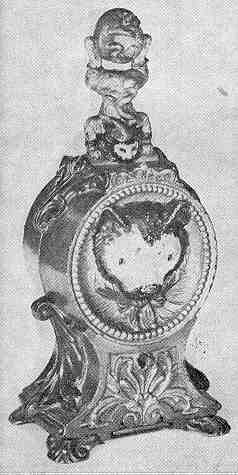Cat and Mouse Bank
by F.H. Griffith - HOBBIES Magazine - November, 1964
 A rather large impressive appearing bank that actually looks more
like a clock than a savings device is our choice as No. 124 in the numerical
classification. This is the Cat And Mouse Bank, and upon first seeing the item few people
would realize that it is an animated toy bank. While no clock face is evident the general
appearance and configuration leaves the impression that it is a clock. In any event, the
bank is a very well made item, unique in both appearance and action.
A rather large impressive appearing bank that actually looks more
like a clock than a savings device is our choice as No. 124 in the numerical
classification. This is the Cat And Mouse Bank, and upon first seeing the item few people
would realize that it is an animated toy bank. While no clock face is evident the general
appearance and configuration leaves the impression that it is a clock. In any event, the
bank is a very well made item, unique in both appearance and action.
The bank was patented April 21, 1891 by James H. Bowen of Philadelphia, Pa. Here again the patent papers are of considerable interest. Please note the picture and in particular the mouse clinging to the ball that is held in the upraised hind legs of the cat. In the patent papers and the drawings specifically this ball is held so that the mouse faced the front and actually revolved with the ball. In other words it was designed by Bowen so that when the action took place the mouse spun around with the ball suspended in the hind paws of the cat. Apparently this was changed by the J. & E. Stevens Company, the manufacturers of the bank, to simplify its production.
As we shall see though this does not follow through smoothly with the continuity of the action as originally planned by Bowen. Although it is possible he made the change himself as it could be the additional mechanism and parts were not practical or feasible to permit this extra action. In addition to this change from the original patent papers, an entirely different figure was possibly used in place of the cat standing on his head as pictured. Several examples of this part were found at the Stevens Company some years ago. In this case a fierce-looking cat is sitting upright and the mouse is held in the mouth of the cat. In addition a kitten has the mouse by the tail. While it is not known how many banks, if any, were actually produced in this fashion, there is no question but that it was felt by certain individuals at Stevens that this was a too realistic representation, likely somewhat unpleasant to children, and thus discarded in favor of the more pleasing figure as shown in the picture herewith.
Leon Perelman of Merion, Pa., is the owner of the excellent specimen shown. It is in original condition with fine paint and the colors are as follows: The overall bank is brown and the ornate parts on each side are a tan color. Sections done in gold include the decorative feet or legs of the base, the front area under the lever, and the circular beading around the large face of the cat. This face is black and white with a large red bow under the mouth. Blue is used to highlight the background of this circular area. The cat standing on its head has a bright yellow costume trimmed in red and blue and the face is painted the same as the larger one. The ball is white with red stripes and the mouse is gray with black eyes. On the base is inscribed the patent date of April 21, 1891. It bears mention that the Cat And Mouse Bank was painted in various ways, that is to say other specimens have the large face of the cat in two tones of gray and the costume of the cat on top in red, some have the overall bank in a gray color instead of brown. In any case, it is a very colorful, attractive bank.
The bank as pictured is shown after the action has taken place. To operate the bank from the position shown the figure on top is pushed backward and it revolves and clicks in place inside the bank. As this is done the figure of a mouse revolves into place on top of the bank. This mouse faces forward. The bank is now ready to operate. A coin is placed in front of the mouse. The lever, under the large cat’s face, is then depressed and the mouse disappears to reappear on the ball as shown in the picture. The coin drops on down inside the bank. Coins are removed by means of the conventional round type Stevens trap.
